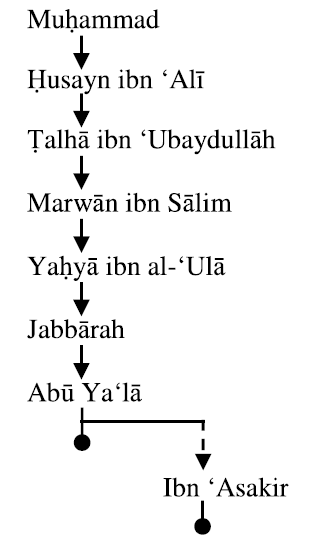|
حَدَّثَنَا جُبَارَةُ حَدَّثَنَا يَحْيَي
بْنُ الْعَلاءِ عَنْ مَرْوَانَ بْن سَالِمٍ عَنْ طَلْحَةَ بْنِ
عُبَيْدِ اللّٰهِ عَنْ حُسَيْنِ قَالَ قَالَ رَسُوْلُ اللّٰهِ
صَلَّي اللّٰهُ عَلَيْهِ وَسَلَّمَ مَنْ وُلِدَ لَهُ فَأَذَّنَ
فِي اُذُنِهِ الْيُمْنَي وَاَقَامَ فِي اُذُنِهِ الْيُسْرَى لَمْ
تَضُرَّهُ اُمُّ الصِّبْيَانِ
Huesayn ibn ‘Ali state that God’s
Messenger said: “He to whom a child was born and he sounded
the adhan in his right ear and the iqamah in the left, then
the child would never be inflicted with [the disease] umm al-sibyan.”
Following is the schematic illustration of the variants of
this narrative’s isnad:

According to al-Hathami and Ibn Hajar, Marwan ibn Salim al-Ghifari
is matruk. The latter also adds that al-Saji and others say
that he fabricates narratives.
Ibn Abi Hatim records: Ahmad ibn Hanbal regards him to be
laysa bi thiqah; Abu Hatim says that his munkar al-hadith
jiddan da‘if al-hadith laysa lahu hadithun qa’imun; when Ibn
Abi Hatim asked his father if his narratives should be
abandoned, he said: la bal la yuktabu hadithuhu.
Ibn al-Jawzi records: Al-Bukhari calls his munkar al-hadith
while al-Nasa’i and al-Daraqutni regard him to be matruk;
according to Ibn Hibban he would narrate manakir from mashahir
and would narrates from trustworthy narrators what is not
sound and when this phenomenon increased, adducing from him
was disallowed.
Al-Dhahabi records: Abu ‘Arubah al-Harani says that he
fabricates his narratives and Ibn ‘Adi is of the opinion that
most of his narratives are not corroborated by reliable
narrators.
Al-Fasawi says that he is munkar al-hadith; it is not
permissible to narrate from him and scholars do write his
narratives only to know them.
Yahya ibn Ma‘in says that he is laysa bi thiqah.
According to Ibn Hajar, Talhah ibn ‘Ubaydullah al-‘Uqayli is
majhul.
Regarding Yahya ibn ‘Ula al-Razi, Ibn Abi Hatim records:
according to Yahya ibn Ma‘in, he is laysa bi shayy; ‘Amr ibn
‘Ali says that he is matruk al-hadith jiddan; Abu Salamah
regards him to be da‘if; Abu Hatim says that he is laysa bi
al-qawi and that Waki‘ has impugned him; Abu Zur‘ah says that
there is du‘f in his narratives.
Al-Nasa’i says that he is matruk al-hadith.
Ibn al-Jawzi records: Waki‘ has severely criticized him; Ahmad
says that he is a liar and fabricates narratives; Yahya says
that he is laysa bi thiqah; ‘Amr ibn ‘Ali, al-Azdi and al-Nasa’i
regard him to be matruk al-hadith; Al-Daraqutni says that he
is da‘if; Ibn ‘Adi says that the weakness in his narratives is
evident and that they are fabricated; Ibn Hibban expresses the
fact that he is alone in narrating maqlubat from trustworthy
narrators and it is not permissible to adduce from him.
Ibn Hajar says that he has been accused of fabrication.
___________________
|